Articles
- Page Path
- HOME > J Korean Acad Nurs > Volume 45(1); 2015 > Article
-
Original Article
- Effects of Special Mouth Care with an Aroma Solution on Oral Status and Oral Cavity Microorganism Growth in Elderly Stroke Patients
- Eun-Hye Lee, Hyojung Park
-
Journal of Korean Academy of Nursing 2015;45(1):46-53.
DOI: https://doi.org/10.4040/jkan.2015.45.1.46
Published online: February 27, 2015
1Division of Nursing Science, Ewha Womans University·Seoul National University Hospital, Seoul, Korea.
2Division of Nursing Science, Ewha Womans University, Seoul, Korea.
- Address reprint requests to: Park, Hyojung. Division of Nursing Science, Ewha Womans University, 52 Ewhayeodae-gil, Seodaemun-gu, Seoul 120-750, Korea. Tel: +82-2-3277-2824, Fax: +82-2-3277-2850, hyojungp@ewha.ac.kr
© 2015 Korean Society of Nursing Science
This is an Open Access article distributed under the terms of the Creative Commons Attribution NoDerivs License. (http://creativecommons.org/licenses/by-nd/4.0/) If the original work is properly cited and retained without any modification or reproduction, it can be used and re-distributed in any format and medium.
Abstract
-
Purpose
- This study was conducted to examine the effect of oral care with an aroma solution on oral status and oral cavity microorganism growth in elderly patients with stroke.
-
Methods
- A non-equivalent control group, with a pretest-posttest design was used in this study. The participants were assigned to the experimental group (n=30) that received oral care with an aroma solution or the control group (n=31) that received 0.9% saline solution. To identify the effect of the experimental treatments, objective/subjective assessments of oral status and oral cavity microorganism growth were performed using the oral assessment guide, oral perception guide, and oral swab culture. Data were analyzed using Chi-square test, Fisher's exact test, and t-test with the SPSS version 21.0 program.
-
Results
- The objective oral status was significantly lower in the experimental group than in the control group (t= -3.64, p<.001). There was no significant difference between the subjective oral status of the experimental group and control groups (t= -1.24, p=.109). Oral microorganism growth was significantly lower in the experimental group than in the control group (t= -7.39, p<.001).
-
Conclusion
- These findings indicate that special mouth care using an aroma solution could be an effective oral health nursing intervention for elderly patients with stroke.
- 1. Counsell C, Warlow C, Sandercock P, Fraser H, van Gijn J. The Cochrane collaboration stroke review group. Meeting the need for systematic reviews in stroke care. Stroke. 1995;26(3):498–502.ArticlePubMed
- 2. British Society of Gerodontology. Guidelines for the oral healthcare of stroke survivors [Internet]. London, UK, Author. 2010;cited 2013 December 11. Available from: http://www.gerodontology.com/content/uploads/2014/10/stroke_guidelines.pdf
- 3. Sue Eisenstadt E. Dysphagia and aspiration pneumonia in older adults. J Am Acad Nurse Pract. 2010;22(1):17–22. ArticlePubMed
- 4. De Visschere LM, van der Putten GJ, Vanobbergen JN, Schols JM, de Baat C. Dutch Association of Nursing Home Physicians. An oral health care guideline for institutionalised older people. Gerodontology. 2011;28(4):307–310. ArticlePubMed
- 5. Park MS. Educational needs in the provision of oral care by nursing staff in long-term care facility for elderly people. J Korean Gerontol Nurs. 2010;12(1):72–80.
- 6. Coleman P, Watson NM. Oral care provided by certified nursing assistants in nursing homes. J Am Geriatr Soc. 2006;54(1):138–143. ArticlePubMed
- 7. Harris DJ, Eilers J, Harriman A, Cashavelly BJ, Maxwell C. Putting evidence into practice: Evidence-based interventions for the management of oral mucositis. Clin J Oncol Nurs. 2008;12(1):141–152. ArticlePubMed
- 8. Lee EN, Ju HO, Kim SM, Park HS, Park MJ, Lee YJ, et al. Comparison of oral hygiene effects between 0.1% chlorhexidine and normal saline on the incidence of oral pathogens. J Korean Acad Fundam Nurs. 2006;13(3):351–358.
- 9. Choi SE, Kim HS. Sodium bicarbonate solution versus chlorhexidine mouthwash in oral care of acute leukemia patients undergoing induction chemotherapy: A randomized controlled trial. Asian Nurs Res. 2012;6(2):60–66. Article
- 10. Baik SH. The effects of xylitol and sorbitol on oral health and xerostomia in Korean elderly. J Korean Gerontol Nurs. 2005;7(1):88–103.
- 11. Jung HJ, Yun JY, Park JE, Shim IS, Kim WJ, Lee JH, et al. Comparison of the effects of lemon ice and water ice on decreasing thirst of the patients with nasal surgery. J Korean Clin Nurs Res. 2012;18(2):196–204.
- 12. Kang HY, Na SS, Kim YK. Effects of oral care with essential oil on improvement in oral health status of hospice patients. J Korean Acad Nurs. 2010;40(4):473–481. ArticlePubMed
- 13. Song JA, Hur MH. Effects of A-solution on halitosis and oral status in preoperative NPO patients. J Korean Acad Nurs. 2012;42(3):405–413. ArticlePubMed
- 14. Oh MY. The effects of A-solution on xerostomia, halitosis, and salivary pH in hemodialysis patients [master's thesis]. Daejeon, Eulji University. 2014.
- 15. Kim NC, Kim HJ. The effects of teatree oil gargling on oral cavity micro-organism growth and perceived discomfort of patient receiving chemotherapy. J Korean Acad Adult Nurs. 2005;17(2):276–286.
- 16. Tadtong S, Suppawat S, Tintawee A, Saramas P, Jareonvong S, Hongratanaworakit T. Antimicrobial activity of blended essential oil preparation. Nat Prod Commun. 2012;7(10):1401–1404.ArticlePubMedPDF
- 17. Johnson VB. Evidence-based practice guideline: Oral hygiene care for functionally dependent and cognitively impaired older adults. J Gerontol Nurs. 2012;38(11):11–19. Article
- 18. Cox SD, Mann CM, Markham JL, Bell HC, Gustafson JE, Warmington JR, et al. The mode of antimicrobial action of the essential oil of Melaleuca alternifolia (tea tree oil). J Appl Microbiol. 2000;88(1):170–175.ArticlePubMed
- 19. Buckle J. Ha HC Kim HS Kang HS . Clinical aromatherapy in nursing. Seoul: Hyunmoon; 2003.
- 20. Lin PW, Chan WC, Ng BF, Lam LC. Efficacy of aromatherapy (Lavandula angustifolia) as an intervention for agitated behaviours in Chinese older persons with dementia: A cross-over randomized trial. Int J Geriatr Psychiatry. 2007;22(5):405–410. ArticlePubMed
- 21. Edris AE. Pharmaceutical and therapeutic potentials of essential oils and their individual volatile constituents: A review. Phytother Res. 2007;21(4):308–323. ArticlePubMed
- 22. Park JH, Sohng KY. Comparison of oral care interventions on the oral status of intubated patients in intensive care units. J Korean Acad Fundam Nurs. 2010;17(3):324–333.
- 23. Bopp M, Darby M, Loftin KC, Broscious S. Effects of daily oral care with 0.12% chlorhexidine gluconate and a standard oral care protocol on the development of nosocomial pneumonia in intubated patients: A pilot study. J Dent Hyg. 2006;80(3):9.
- 24. Eilers J, Berger AM, Petersen MC. Development, testing, and application of the oral assessment guide. Oncol Nurs Forum. 1988;15(3):325–330.PubMed
- 25. Jung YY. Reliability testing of an oral assessment guide for patients receiving stomatoxic treatment. Seoul J Nurs. 1996;10(1):45–51.
- 26. Beck S. Impact of a systematic oral care protocol on stomatitis after chemotherapy. Cancer Nurs. 1979;2(3):185–199.ArticlePubMed
- 27. Park YJ. The influence of saline and betadine solution for gargle in the leukemic patients receiving chemotherapy [master's thesis]. Gwangju, Chonnam National University. 1997.
- 28. Jo YM. The effects of oral care protocols on bacterial floras of oral cavity and oral status in intubated patients [master's thesis]. Chuncheon, Kangwon National Unversity. 2011.
- 29. Worwood VA. The complete book of essential oils & aromatherapy. San Rafael, CA: New World Library; 1991.
- 30. Fine DH, Furgang D, Barnett ML, Drew C, Steinberg L, Charles CH, et al. Effect of an essential oil-containing antiseptic mouthrinse on plaque and salivary Streptococcus mutans levels. J Clin Periodontol. 2000;27(3):157–161.ArticlePubMed
REFERENCES
Figure & Data
REFERENCES
Citations

- The Effects of Aromatherapy on Stroke Symptoms in Stroke Patients: A Systematic Review and Meta-Analysis
A Reum Lim, Hyun Kyoung Kim
Korean Journal of Adult Nursing.2024; 36(2): 85. CrossRef - Effect of Honey-based Oral Care on Oral Health of Patients With Stroke Undergoing Rehabilitation: A Randomized Controlled Trial
A-Ra Cho, Hyunmi Son, Gyumin Han
Asian Nursing Research.2024; 18(3): 215. CrossRef - The impact of aromatherapy-based oral care on oral conditions, salivary pH, and halitosis in older adults with dementia: Pilot study
Ae Kyung Chang, Bo kyoung Kim, Ah Young Kim
Geriatric Nursing.2023; 53: 109. CrossRef - Effects of Oral Gargling with Aroma Solution in Psychiatric Inpatients: A Non-Randomized Controlled Trial
Yun Ah Jung, Hee Sook Kim
Journal of Korean Academy of Nursing.2020; 50(2): 200. CrossRef
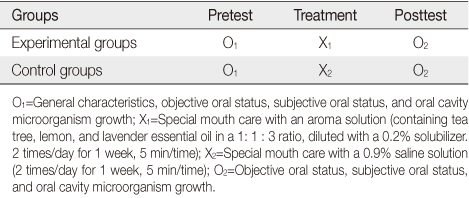
Figure 1
Homogeneity Test of General, Disease, and Oral-health related Characteristics between the Two Groups (N=61)
*Fisher's exact test; †Plural response; Exp.=Experimental group; Cont.=Control group.
Homogeneity Test for Outcome Variables between the Two Groups (N=61)
Exp.=Experimental group; Cont.=Control group.
Comparison of Outcome Variables between the Experimental and Control Group (N=61)
Exp.=Experimental group (n=30); Cont.=Control group (n=31).
Frequencies of Microorganism Occurrence in Oral Cavity between the Experimental and Control Group (N=61)
Exp.=Experimental group; Cont.=Control group; MRSA=Methicillin Resistant Staphylococcus Aureus.
*Fisher's exact test; †Plural response; Exp.=Experimental group; Cont.=Control group.
Exp.=Experimental group; Cont.=Control group.
Exp.=Experimental group (n=30); Cont.=Control group (n=31).
Exp.=Experimental group; Cont.=Control group; MRSA=Methicillin Resistant Staphylococcus Aureus.
 KSNS
KSNS
 E-SUBMISSION
E-SUBMISSION

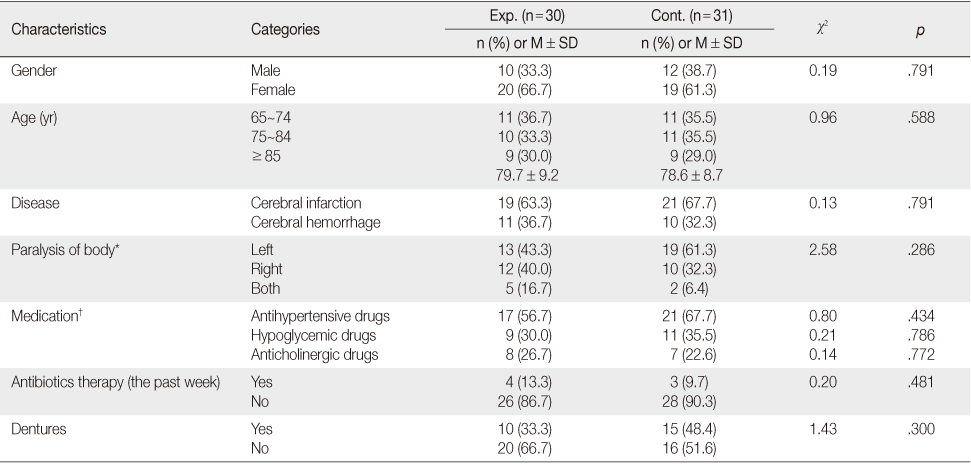
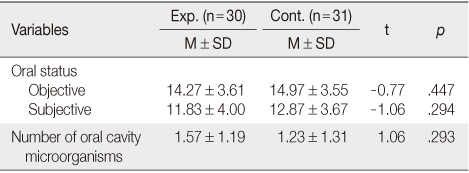
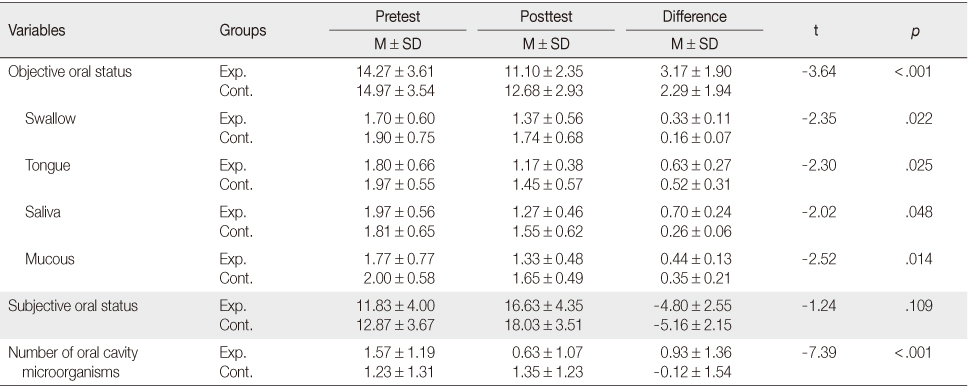
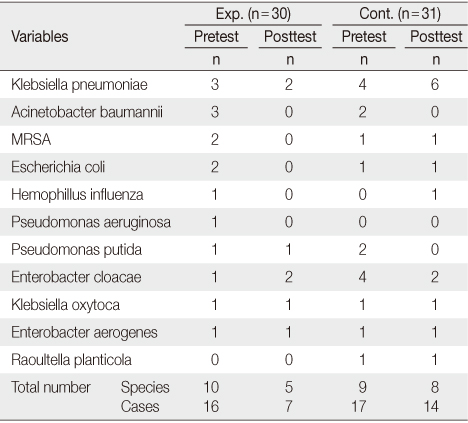
 Cite
Cite

